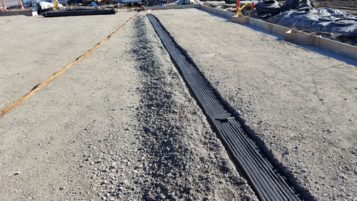
By Wes Robb
Vapor barriers…are they all the same? What is the difference between a vapor barrier and a moisture barrier? Isn’t a water vapor barrier the same as soil and gas vapor barrier?
There is a good deal of confusion in the industry about vapor barriers. The terms vapor barrier and moisture barriers are often used interchangeably when they are very different elements designed for very different purposes. Adding to the confusion is the fact that many label moisture barriers as “water vapor barriers” as a way to distinguish them from soil gas vapor barriers. There is a good deal of information that needs to be sorted out. Installing one when the other is required can lead to a great deal of added labor and expense.
Often, when people in the industry refer to vapor barriers, or water vapor barriers, what they are really speaking about is a moisture barrier. These barriers are constructed within a building with the key driver being to keep moisture out of the building. They can be located in the underground walls and sub-slab of buildings as a way to keep the water out. Architects specify moisture barriers as a way to prevent water from accumulating in the walls and below the slab of a building. Water buildup can cause levels of structural damage to the building and can lead to unwanted moisture-related problems, such as mold. The barrier acts as a way to keep moisture out.
The other type of “vapor barrier,” otherwise known as a soil gas vapor barrier or vapor mitigation barrier, is used to prevent dangerous chemical vapors from making their way into a building. If this dangerous chemical vapor is not properly blocked and vented, the breathing zone of a building can become contaminated, posing serious short- and long-term health risks. This is a relatively new concern for those in the industry, but the EPA has continually released studies regarding the importance of a true vapor mitigation system both in new building construction and existing buildings, which are situated above contaminated vapor below the surface. This phenomenon is known in the industry as vapor intrusion. The risk of vapor intrusion occurs when there is the potential of a migration of petroleum products or volatile chemical from contaminated groundwater, soil or a vapor plume into an overlying building. These volatile chemicals have the ability to migrate through subsurface soils and into the breathing zone much in the same way that radon gas seeps into homes and commercial buildings. Vapor intrusion is a known health risk for occupants of the buildings it affects, and can lead to costly litigation.
A vapor mitigation system can come in various forms, but commonly a vapor intrusion barrier is a composite membrane system. This solution has the advantages of chemically resistant, high-density polyethylene, combined with the benefits of spray-applied membranes. However, what makes this vastly different than a common moisture barrier is the chemical-resistant nature of the vapor barrier membrane and the venting system that lies below the vapor-resistant membrane. The venting system is custom designed for the footprint of the building that is affected. It allows the chemical vapors held back from migrating into the building by the vapor membrane barrier to be vented out of the sub-slab of the building through a vent pipe. This directs the potentially harmful vapors away from the building and, more importantly, the breathing zone of its occupants.
It is crucial that a contractor knows exactly what is specified for the site. If the site conditions dictate that a soil gas vapor mitigation barrier is required, it is imperative that one be installed. Otherwise, in the future, potential health hazards could be a concern. What are the site conditions that generally dictate this kind of requirement? As previously stated, vapor intrusion is often caused by petroleum products or volatile chemicals in the soil, groundwater and/or soil vapor. This means that if a construction site is on or near an area where a gasoline station, automotive repair shop, dry cleaner, metal fabricator or businesses utilizing vapor degreasers had previously or is operating today, a vapor mitigation barrier may very likely be required.
It is critical for a construction superintendent to understand whether or not the architect’s plans call for a moisture barrier or a more complex vapor barrier, possibly complete with a full vapor mitigation venting system. As vapor mitigation systems are relatively new to most individuals, it may not be clear in the construction plan details whether the barrier specified is for moisture or soil gas vapor. If there is any question, the most prudent option is to review the plans with the project manager, architect and/or environmental consultant to make sure everyone understands what is required, and no work has to be redone. Speaking with the team and fully understanding what is required before construction starts will save time and money in the long term.
Wes Robb, director of technical strategies and applications at Vapor Mitigation Strategies, has more than 23 years of environmental field and laboratory experience. To learn more, visit: www.vapormitigationstrategies.com.




 Join our thriving community of 70,000+ superintendents and trade professionals on LinkedIn!
Join our thriving community of 70,000+ superintendents and trade professionals on LinkedIn! Search our job board for your next opportunity, or post an opening within your company.
Search our job board for your next opportunity, or post an opening within your company. Subscribe to our monthly
Construction Superintendent eNewsletter and stay current.
Subscribe to our monthly
Construction Superintendent eNewsletter and stay current.